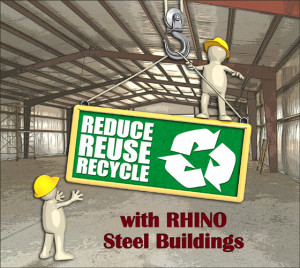Building Green with Pre-engineered Metal Buildings
Eco-friendly pre-engineered steel buildings meet all the criteria for a green, environmentally conscious building material.
Steel production’s efficiency— and the efficient processes of designing, engineering, and manufacturing the structure— eliminates waste. Read on to learn why you should build environmentally efficient buildings made of steel.
Reduce, Reuse, Recycle
 Living green requires using resources wisely.
Living green requires using resources wisely.
The U.S. Environmental Protection Agency’s (EPA) mantra “reduce, reuse, and recycle,” admonishes us to stretch natural resources.
Choosing green building materials like steel framing stretches resources.
The strength of steel reduces the amount of framing material needed to create a strong, durable structure.
When a steel structure outlives its usefulness, the framing can be reused to create other steel products— or another steel building— by recycling.
The New, Greener Steel Reduces the Environmental Footprint
The steel industry spent billions of dollars in recent years to make producing steel a more environmentally friendly process.
- Steel production today requires 34% less energy to produce than it did 40 years ago.
- Today, 95% of the water used in steel processing is reused.
- Scrap steel is an essential ingredient of today’s steel.
- Recycling steel takes less energy than producing virgin steel from iron ore. Every ton of steel recycled saves 10.9 million Btu’s of energy, 2,500 pounds of iron ore, 1,400 pounds of coal, and 120 pounds of limestone.
- The North American steel industry began recycling over 170 years ago.
Steel Buildings: Recycled Efficiently
Steel is the most recycled material in the world. It is the only material that can be recycled countless times without changing its strength. No other building material can make that claim!
- Every steel product contains recycled steel.
- 100% of the steel framing and steel cladding used in RHINO metal buildings is recyclable at the end of the structure’s lifetime.
- All steel contains at least 28% recycled material. Structural steel averages 77% recycled material. RHINO’s framing contains up to 90.7% recycled steel.
- Framing a typical 2,000 sq. ft. wood-framed structure requires about an acre of forest. Constructing the same structure with a pre-engineered metal building saves an acre of trees by using the steel recycled from six to eight old, junked cars. Today, 93% of all scrapped automobiles are recycled.
- The more steel products we recycle, the less wind up taking up room in overcrowded landfills. Every ton of steel recycled saves about 250 cubic feet of space in a landfill.
How You Can Save Energy with Metal Buildings
Well-insulated metal buildings also save energy during use.
- According to the U.S. Department of Energy, buildings account for 40% of all the energy consumed.
- Americans use one-sixth of all the energy generated in the U.S. just to air-conditioned buildings.
- RHINO’s Pro-Value Insulation System cuts energy usage in half.
- Choosing cool-coated metal roofing reduces building energy expenditures by 7% to 15% in warm climates. Cool-coated steel roofing retains 95% of its reflectivity over the years of use.
The Longevity of Metal Buildings Conserves Resources
The longer a product’s lifecycle, the less negative impact it has on the environment.
- Steel buildings last decades longer than other types of structures.
- Sustainable metal buildings face adverse conditions better than other structures. Steel buildings resist damage from wind, snow, earthquakes, fire, lightning, and termites far better than other building systems.
- The fewer trees sacrificed for wood building, the more trees remain cleaning the air and replenishing the atmosphere with life-giving oxygen.
Buy Green. Buy RHINO Steel Buildings.
We invite you to call RHINO at 940.383.9566 at your convenience to discuss your green building project.
